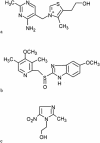Pyruvate decarboxylase, the target for omeprazole in metronidazole-resistant and iron-restricted Tritrichomonas foetus
- PMID: 15155220
- PMCID: PMC415579
- DOI: 10.1128/AAC.48.6.2185-2189.2004
Pyruvate decarboxylase, the target for omeprazole in metronidazole-resistant and iron-restricted Tritrichomonas foetus
Abstract
The substituted benzimidazole omeprazole, used for the treatment of human peptic ulcer disease, inhibits the growth of the metronidazole-resistant bovine pathogen Tritrichomonas foetus in vitro (MIC at which the growth of parasite cultures is inhibited by 50%, 22 microg/ml [63 microM]). The antitrichomonad activity appears to be due to the inhibition of pyruvate decarboxylase (PDC), which is the key enzyme responsible for ethanol production and which is strongly upregulated in metronidazole-resistant trichomonads. PDC was purified to homogeneity from the cytosol of metronidazole-resistant strain. The tetrameric enzyme of 60-kDa subunits is inhibited by omeprazole (50% inhibitory concentration, 16 microg/ml). Metronidazole-susceptible T. foetus, which expresses very little PDC, is only slightly affected. Omeprazole has the same inhibitory effect on T. foetus cells grown under iron-limited conditions. Similarly to metronidazole-resistant cells, T. foetus cells grown under iron-limited conditions have nonfunctional hydrogenosomal metabolism and rely on cytosolic PDC-mediated ethanol fermentation.
Figures



References
-
- Čerkasovová, A., J. Čerkasov, and J. Kulda. 1984. Metabolic differences between metronidazole resistant and susceptible strains of Tritrichomonas foetus. Mol. Biochem. Parasitol. 11:105-118. - PubMed
-
- Cole, S. T., R. Brosch, J. Parkhill, T. Garnier, C. Churcher, D. Harris, S. V. Gordon, K. Eiglmeier, S. Gas, C. E. Barry III, F. Tekaia, K. Badcock, D. Basham, D. Brown, T. Chillingworth, R. Connor, R. Davies, K. Devlin, T. Feltwell, S. Gentles, N. Hamlin, S. Holroyd, T. Hornsby, K. Jagels, B. G. Barrell, et al. 1998. Deciphering the biology of Mycobacterium tuberculosis from the complete genome sequence. Nature 393:537-544. - PubMed
-
- Cole, S. T., K. Eiglmeier, J. Parkhill, K. D. James, N. R. Thomson, P. R. Wheeler, N. Honore, T. Garnier, C. Churcher, D. Harris, K. Mungall, D. Basham, D. Brown, T. Chillingworth, R. Connor, R. M. Davies, K. Devlin, S. Duthoy, T. Feltwell, A. Fraser, N. Hamlin, S. Holroyd, T. Hornsby, K. Jagels, C. Lacroix, J. Maclean, S. Moule, L. Murphy, K. Oliver, M. A. Quail, M. A. Rajandream, K. M. Rutherford, S. Rutter, K. Seeger, S. Simon, M. Simmonds, J. Skelton, R. Squares, S. Squares, K. Stevens, K. Taylor, S. Whitehead, J. R. Woodward, and B. G. Barrell. 2001. Massive gene decay in the leprosy bacillus. Nature 409:1007-1011. - PubMed
-
- Diamond, L. S. 1957. The establishment of various trichomonads of animals and man in axenic cultures. J. Parasitol. 43:488-490. - PubMed
Publication types
MeSH terms
Substances
LinkOut - more resources
Full Text Sources

